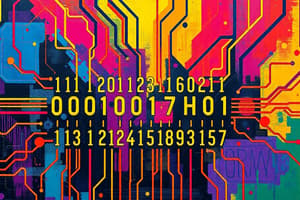Podcast
Questions and Answers
What is the main difference between analog and digital encoders?
What is the main difference between analog and digital encoders?
- Analog encoders are used for motion control, while digital encoders are used for position sensing
- Analog encoders are more accurate than digital encoders
- Analog encoders provide continuous signals, while digital encoders offer discrete states (correct)
- Analog encoders are more complex than digital encoders
What are some common applications of encoders?
What are some common applications of encoders?
- Electronics manufacturing, construction, and agriculture
- Telecommunications, energy, and transportation
- Robotics, industrial equipment, and consumer products (correct)
- Automotive, aerospace, and medical equipment
What is one advantage of using encoders compared to multiplexers?
What is one advantage of using encoders compared to multiplexers?
- Encoders have higher accuracy and responsiveness
- Encoders can convert a variable number of inputs into a variable number of outputs
- Encoders have lower error potential in data transmission (correct)
- Encoders are less complex and more flexible
What is one disadvantage of using encoders compared to multiplexers?
What is one disadvantage of using encoders compared to multiplexers?
Which of the following is the most important factor in choosing between analog and digital encoders?
Which of the following is the most important factor in choosing between analog and digital encoders?
Flashcards are hidden until you start studying
Study Notes
Encoders: Understanding Input and Output Translation in Digital Systems
Introduction to Encoders
In digital systems, encoders play a crucial role in converting a set of binary inputs into a unique binary code that represents the position of the input. They are essential for tasks such as motion control and feedback in machinery across various industries. Encoders are used in cut-to-length applications, plotters, robotics, packaging, conveying, automation, sorting, filling, imaging, and many more.
Basic Principle of Encoders
The basic principle of an encoder involves assigning a unique binary code to each possible input. These codes represent the position of the input and are used to identify the specific input that is active. Encoders can be used to convert multiple inputs into a single serial code, thereby reducing the possibility of errors in the transmission of information.
Types of Encoders
Parallel to Serial Encoders
These encoders convert a parallel set of inputs into a serial code. Examples include 2-to-4 line encoders, which have 2 input lines and 4 output lines, assigning a unique 4-bit binary code to each of the 2^2 = 4 inputs. The most common types of parallel to serial encoders are priority encoders, which assign a priority to each input, and binary-weighted encoders, which use a binary weighting system to assign binary codes to inputs.
Analog vs. Digital Encoders
Analog encoders provide continuous signals, while digital encoders offer discrete states. The choice between analog and digital encoders depends on the specific requirements of the system, such as the need for high accuracy and responsiveness.
Applications
Encoders are widely used in machinery for motion feedback and motion control, such as robotics, industrial equipment, and consumer products. They are designed to track motor shaft movement for various pieces of industrial equipment and commercial devices.
Advantages and Disadvantages
Advantages of using encoders include reduced error potential in data transmission, improved performance, and increased efficiency in converting multiple inputs into a single serial code. However, encoders can be more complex compared to multiplexers, and their flexibility is limited to specific applications and the conversion of a fixed number of inputs into a fixed number of outputs.
Studying That Suits You
Use AI to generate personalized quizzes and flashcards to suit your learning preferences.




